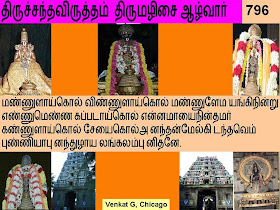Thirumazhisai Azhwar
Thiruchandaviruththam
Thirumozhi 5 (792-801) Chanting
Thirumazhisai Azhwar also known as Bakthisarar was born on Thai Magam. as Aazhi(discus) amsam of Lord Sriman Narayana. Born to Bhargava maharishi and his wife Kanakangi and brought up by Thiruvalan and Pankajavalli, a local tribal couple. Born as a pinda was transformed into a divya Swarupa by Lord Narayana and His consort. Thirumazhisai Azhwar's Bakthi to Lord Narayana's Para, Archa and Antharyami Swarupams were so deep that the Lord Narayana was at his beck and call as evidenced by the Sonna Vannam Perumal going out and in of Kanchi and the Antharyami giving Darshan of his Para Swarupam on the thirumeni of Thirumazhsai Azhwar.
He composed Thiruchanda Viruththam (120 pasurams) and Nanmugan Thiruvandhadhi(96 pasurams). Both are Bakthi laden pasurams in Para, Archa and Antharyami Swarupam of Lord Narayana. At one point he threw the palm leaves containing these two prabhandhams into flowing cauvery but they came back to his feet showing the value of these pasurams.
Adiyen has made an attempt to chant these 120 pasurams ( 12 Thirumozhi of 10 pasurams each) in a tune that I could manage.
Here is the Fifth Thirumozhi
He composed Thiruchanda Viruththam (120 pasurams) and Nanmugan Thiruvandhadhi(96 pasurams). Both are Bakthi laden pasurams in Para, Archa and Antharyami Swarupam of Lord Narayana. At one point he threw the palm leaves containing these two prabhandhams into flowing cauvery but they came back to his feet showing the value of these pasurams.
Adiyen has made an attempt to chant these 120 pasurams ( 12 Thirumozhi of 10 pasurams each) in a tune that I could manage.
Here is the Fifth Thirumozhi



















